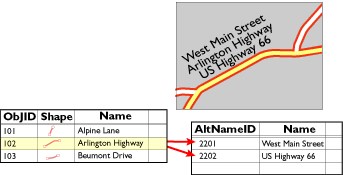Although finding locations for addresses is a common practice, you can also use locators to find features based on the name of a location, such as a shopping center or business office. Locators also allow you to search based on a code, such as a postal code, census tract, tax ID, parcel ID, postal code, or coordinates based on a spatial reference system. If you have data related to an intersection rather than an address, such as the location of an auto accident, searching by an intersection or using a spatial offset on a found address is helpful.
Geocoding can be extended to support matching different types of locations. Here are a few recommendations on how to enhance your geocoding search.
Searching for atypical address locations
Depending on your particular application, you may find that the traditional address format does not accommodate the type of search you need to perform. One example of this is when looking for specific regions or point locations, you may need to geocode values according to a block ID, borehole ID, or pipeline identifier, or your application requires that you geocode values to particular watersheds or bioregions. Searching based on properties of a specific region or a geographic feature can be performed using the General—Single Field address locator style.
The General—Gazetteer locator style allows you to create locators for finding names of any kind of features such as schools, points of interest, or city landmarks.
Searching a location based on a city, state, and country can be done by creating a locator using the General—City State Country locator style. If you have an application that requires using two or three input fields, you can substitute the fields with any data you have. For example, if your building floor plan feature class contains a Room_number field and an Employee_name field, you can create a locator based on the General—City State Country locator style using these two fields instead. In the Create Address Locator dialog box, you can choose the Room_number and Employee_name fields for City Name and State, respectively, and leave the Country field empty. This is illustrated in the following graphic:

Searching for features with alternate names
Sometimes streets or cities in address data are referenced by more than one name. For example, a highway might be known by a street name as well as a particular highway number. Street names and city names can change over time. In these instances, you may find that your address data refers to the same location using a variety of alternate names.

To geocode these locations, an address locator can be created using an alternate name table. Using this locator, you can geocode locations based on the name specified in the primary feature class or the alternate name table.
Learn more about building an address locator for alternate namesSearching for place-names
Your application may require the use of location names, such as schools or hospitals, as your input address. This is feasible if you provide the address locator with a table containing the location or alias name as well as the address data required by your address locator style.
Once a locator has been created and provided with a place-name alias table, you can geocode locations based on the alias name. This is done by entering the place-name as an input address. The address locator will search for the location based on the alias name's corresponding address.
Learn more about building an address locator for place-name aliases
Finding an intersection
If searching for a location based on the full address that includes a house number and street is not possible, you can geocode the street intersection or the joining point of two features. Each address locator style that uses a polyline feature class also provides a means of translating the names of two features into an x,y coordinate value if they intersect.
Searching with composite locators
Once you have created or collected locators from various sources for searching different type of locations, you can combine them to form a composite locator. Creating a composite address locator allows you to set up a cascade system. Addresses not matched with the first locator will fall back to be matched with the second locator, and so on. Using a composite locator consisting of locators with all possible types of location information, you can geocode a very wide range of location data. For example, a composite locator can contain locators in the following list:
- Street addresses
- City and state names
- Place-name gazetteer
- Postal codes
- Census tracts
- Telephone numbers
- Building footprints
- Floor plans
- Spatial reference system coordinates
Learn more about creating a composite address locator